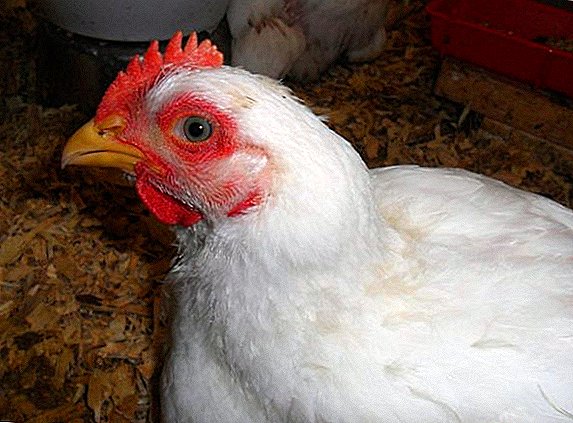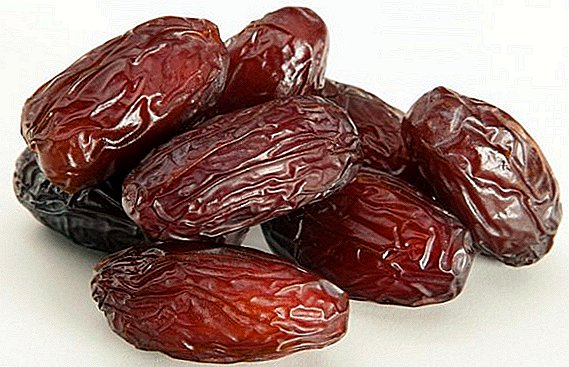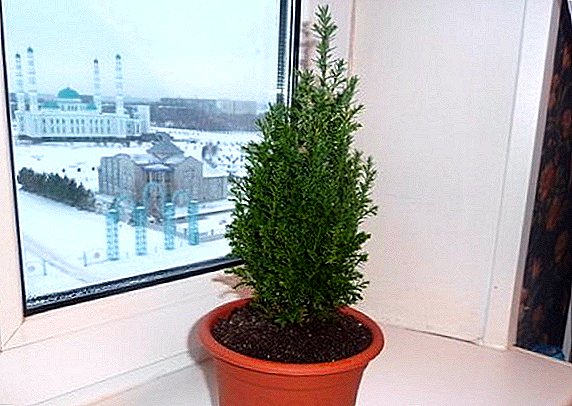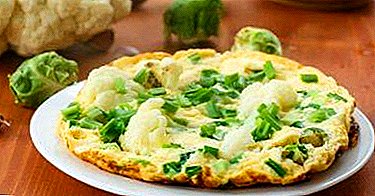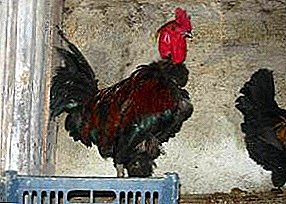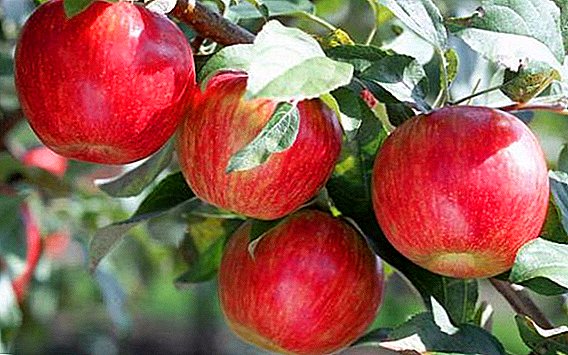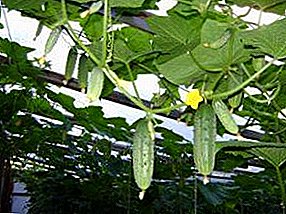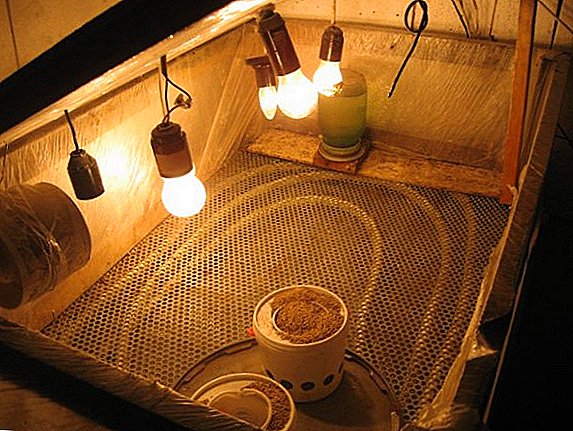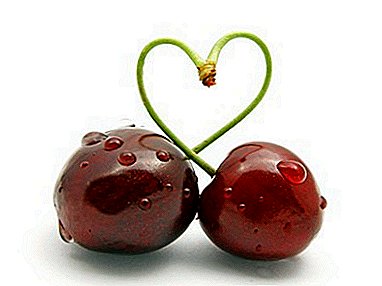
Cultivar Lebedyanskaya has an excellent yield - up to 7 kilograms of fruit from one tree. Fruits resemble the shape of hearts.
It has a universal direction. Tree has tall, reaching 3.0-3.5 meters. Propagated by budding.
Further in the article you will read the description of the Lebedyanskaya variety, you will see how this cherry looks like.
Breeding history and breeding region
 The variety was bred in the All-Russian Research Institute of Horticulture named after IV Michurin (VNIIS).
The variety was bred in the All-Russian Research Institute of Horticulture named after IV Michurin (VNIIS).
Reference. VNIIS - It is a technological organization dedicated to the study of scientific trends in horticulture.
Dessert Morozova, Morozovka and Uralskaya Rubinovaya were also born at this institute.
The main focus: the sorting of fruit trees and the selection of new plant forms, disease resistance and ecology, the cultivation and reproduction of cuttings for planting, mechanization, technological methods of growing adult trees, proper storage of fruits.
The institute applies the modeling and production of environmentally friendly products. In the study of varieties is the automation of processes. The organization implements innovative projects of different directions.
University developments have gained wide popularity among professionals and amateur gardeners.
Latin name: Cerasus. Grade author: Т.В. Morozov.
The tree was obtained in 1990 from the bones of the cherry variety Vladimirskaya. In the growth stage, the seed was treated with a solution of mutagen EC.
It survives well in the middle and southern part of Russia, Ukraine and Belarus.
Bred specifically for the Black Earth region. Distributed in Michurinsk, Voronezh, Rostov-on-Don, Pavlovsk.
Appearance of cherry Lebedyanskaya
Consider separately the appearance of the tree and fruit.
Tree
 Cherry tree is considered fast growing, because for the year reaches the meter mark. It has high growth - up to 3.0-3.5 meters. Comparable in growth with this variety plum Volga beauty, pears Hera and Victoria.
Cherry tree is considered fast growing, because for the year reaches the meter mark. It has high growth - up to 3.0-3.5 meters. Comparable in growth with this variety plum Volga beauty, pears Hera and Victoria.
Requires professional pruning crown. Crohn plants in the form of a pyramid. The leaves are thick.
Bark on the main branches and short boles has a chestnut tint. Shoots of dark brown shade, large in size, with a small number of lentils.
Kidney large, rounded ovoid in shape, slightly deviated from the branches. The foliage is large, oval-rounded with a dark emerald shade. It has radiant bicuspid serrations and a flat, smooth relief. Downiness is absent.
Chereshki leaves have anthocyanin shade. Weight and elongation of medium sized petioles. At the end of the leaf plate there are small pieces of iron in the amount of 1-2 pieces. Color glands burgundy.
Leaf plates shape elongated with a weak incision. Fall off late. Fruiting occurs on the bouquet of fruit stalks.
Fetus
Fruits are medium sized, in weight reach from 3.0 to 4.5 grams. Rossoshanskaya, Ashinskaya steppe and Molodezhnaya can boast the same size of berries. The top of the fruit is rounded with a small depression at the stem of the cherry. And the bottom is pointed. Because of this, they resemble the shape of hearts.
Have a small abdominal suture. The stem is elongated with easy separation of the fruit from the branches. Fruits of a maroon shade without top points.
When fully matured - almost black. Bone inside the berries are medium in size.
 The shape is round, does not cause cuts in the mouth. Well separable from the core. Pulp cherries dark burgundy hue.
The shape is round, does not cause cuts in the mouth. Well separable from the core. Pulp cherries dark burgundy hue.
Very gentle, dense, with plentiful juice. The juice of the berries is dark red-burgundy. The taste is sweet, with a slight sourness. Excellent juice is also obtained from the varieties Zhukovskaya, Lyubskaya and Malinovka.
Cherry Lebedyanskaya - a description of its chemical composition:
| Composition | Quiche |
|---|---|
| Sugar | from 11.0% to 11.64% |
| Acids | from 1.0% to 1.37% |
| Vitamin C | from 34.0 to 34.66 mg per 100 g |
A photo





Characteristic variety
Thanks high sugar content, the grade is appreciated as a production dessert. It has a universal direction. Him easy to recycle. Tasty jam, kissel, compotes, tinctures and concentrated juices are made from Lebedyanskaya cherry berries.
Dessert can be varieties of not only cherries, but also apple trees with pears. For example, the variety Dessert Petrova, Dessert Rossoshanskaya and Moskvichka.
Flowering Lebedyanskaya cherry occurs within two weeks in the 20th of May. Flowers with a pink-white shade. Petals of flowers are ovate-rounded. Stamens are located below the stigma of the pistil.
This cherry variety is self-fertile. But when using pollinators, yields are significantly improved.
For "Lebedyanskaya" cherries, the best pollinators are considered to be: "Vladimirskaya" cherry, frost-resistant Freezer, high-yielding Zhukovskaya and drought-resistant Turgenevka.
 Harvesting takes place at 4 or 5 years after planting. cutting. The ripening time of berries is moderate, reaches full maturity. in the second half of July. Fruit ripening one-time. Productivity is high.
Harvesting takes place at 4 or 5 years after planting. cutting. The ripening time of berries is moderate, reaches full maturity. in the second half of July. Fruit ripening one-time. Productivity is high.
One tree gives from 6.5 to 7.0 kilograms of berries. From one hectare of land is collected from 60 to 80 quintals. Suitable for systematic mechanized harvesting.
By the high-yielding varieties also belong to the Minx, Chernokorka and Generous.
Possesses remarkable transportability over long distances and excellent technical qualities of berries.
Cherry Lebedyanskaya possesses good drought tolerance. Cherry hardiness is excellent. Winter hardiness of color buds is low only in the northern regions of the country.
Good winter hardiness manifest varieties Tamaris, Zhivitsa and Tsarevna.
Planting and care
- Landing place
The pruning of the tree is done similarly with the usual Turgenevka and Zhukovskaya cherries. Pruning is done before the appearance of the kidneys. It is necessary to leave 5 or 6 developed branches.
The distance between them should be at least 10 centimeters. The rest is removed without leaving hemp. The wounds of the tree are immediately covered with garden pitch.
For planting cuttings should be chosen place with excellent passage of sunlight. Landing is made from the south side of the buildings. It is best to plant along the fence, where there is the softest microclimate.
The selected site should be with the possibility of accumulation of a large amount of snow in winter. Snow protects the plant and does not allow it to freeze in the winter period of time. Loves loamy soil.
- Preparing for landing
 Excellent response to bait and rich in vitamins land. It is better to choose the soil with a remarkable breathability.
Excellent response to bait and rich in vitamins land. It is better to choose the soil with a remarkable breathability.Landing site should not be close to water.. It is necessary to drain the soil.
When buying a ready seedling, its root system must be wrapped in moss or peat and carefully wrapped in plastic transport film.
Seedlings must be grafted and have a developed root system. Elevated part of the stalk need to cut to 55-70 centimetersthat allows you to properly form a plant on the plot.
- Reproduction by budding
Reproduction occurs with budding. It behaves well on the rootstocks of clones of fruit trees of the Vladimirsky variety and on various garden seed varieties.
Budding spend in the second decade of July. Time: 14-21 days. 6-8 days before grafting, the bark of the tree is watered with warm or room temperature water. Such a procedure stimulates sap flow. The bark should be well separated.
Before budding, all shoots and leaves in the vaccination area must be removed. The scape is chosen long, reaching 6-8 millimeters. All fruit buds on such growths are vegetative.
- Graft
 On the rootstock, make a cut of the bark of a tree, 3 centimeters long, and in the middle - a small transverse incision.
On the rootstock, make a cut of the bark of a tree, 3 centimeters long, and in the middle - a small transverse incision.In this procedure, the tip disappears, and a graft is inserted into the lower part.
According to its width, it should coincide with the cut made. Vaccination site tied with plastic wrap. The kidney is left open. After 14-21 days you need to check the survival of the eyes.
When pressed lightly, the leaf stalk should separate. This means that the kidney has successfully settled down. After 30 days, the harness is removed. In winter time, the place of budding is protected from frost. In early spring, the adherent patches should have a smooth surface with a smooth bud.
Diseases and pests
Possesses good resistance to various fungal diseases.
The Lebedyanskaya cherry variety is not susceptible to moniliosis, anthracnose, perforated spotting. Resistance to coccomycosis is moderate.
Podbelskaya, Pamyati Yenikeeva, Kharitonovskaya and Fairy are highly resistant to coccomycosis.
For the treatment of coccomicosis use Biofungicide drug "Fitosporin". All infected leaves must be burned. If this is not done, the bacteria of the causative agent of this disease overwinter and the next year the plant will fall ill again.
Conclusion. The variety has good yield. From one hectare of land they harvest from 60 to 80 centners of fruit. Suitable for automated harvesting.
 It has excellent quality berries. Fruits of burgundy color, resemble the shape of hearts Bone inside the berries are medium in size. Due to the high sugar content, the variety is valued as a production dessert.
It has excellent quality berries. Fruits of burgundy color, resemble the shape of hearts Bone inside the berries are medium in size. Due to the high sugar content, the variety is valued as a production dessert.
It has a universal direction. Reproduction occurs with budding. It has good resistance to various fungal diseases. Resistance to coccomycosis is moderate. Bred specifically for the Black Earth region.


 Excellent response to bait and rich in vitamins land. It is better to choose the soil with a remarkable breathability.
Excellent response to bait and rich in vitamins land. It is better to choose the soil with a remarkable breathability. On the rootstock, make a cut of the bark of a tree, 3 centimeters long, and in the middle - a small transverse incision.
On the rootstock, make a cut of the bark of a tree, 3 centimeters long, and in the middle - a small transverse incision.
